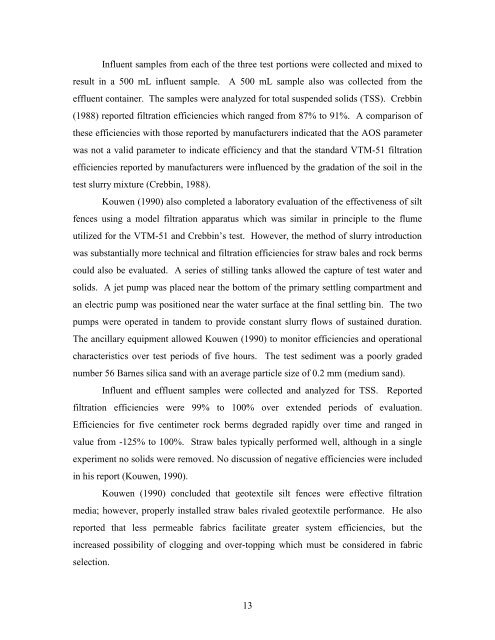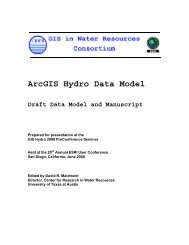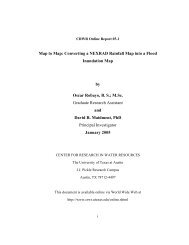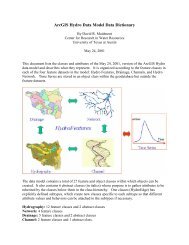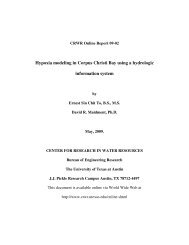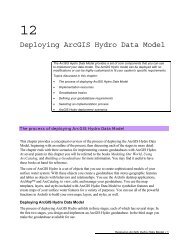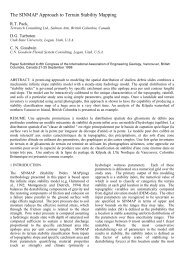View the Whole Report - Center for Research in Water Resources ...
View the Whole Report - Center for Research in Water Resources ...
View the Whole Report - Center for Research in Water Resources ...
You also want an ePaper? Increase the reach of your titles
YUMPU automatically turns print PDFs into web optimized ePapers that Google loves.
Influent samples from each of <strong>the</strong> three test portions were collected and mixed to<br />
result <strong>in</strong> a 500 mL <strong>in</strong>fluent sample. A 500 mL sample also was collected from <strong>the</strong><br />
effluent conta<strong>in</strong>er. The samples were analyzed <strong>for</strong> total suspended solids (TSS). Crebb<strong>in</strong><br />
(1988) reported filtration efficiencies which ranged from 87% to 91%. A comparison of<br />
<strong>the</strong>se efficiencies with those reported by manufacturers <strong>in</strong>dicated that <strong>the</strong> AOS parameter<br />
was not a valid parameter to <strong>in</strong>dicate efficiency and that <strong>the</strong> standard VTM-51 filtration<br />
efficiencies reported by manufacturers were <strong>in</strong>fluenced by <strong>the</strong> gradation of <strong>the</strong> soil <strong>in</strong> <strong>the</strong><br />
test slurry mixture (Crebb<strong>in</strong>, 1988).<br />
Kouwen (1990) also completed a laboratory evaluation of <strong>the</strong> effectiveness of silt<br />
fences us<strong>in</strong>g a model filtration apparatus which was similar <strong>in</strong> pr<strong>in</strong>ciple to <strong>the</strong> flume<br />
utilized <strong>for</strong> <strong>the</strong> VTM-51 and Crebb<strong>in</strong>’s test. However, <strong>the</strong> method of slurry <strong>in</strong>troduction<br />
was substantially more technical and filtration efficiencies <strong>for</strong> straw bales and rock berms<br />
could also be evaluated. A series of still<strong>in</strong>g tanks allowed <strong>the</strong> capture of test water and<br />
solids. A jet pump was placed near <strong>the</strong> bottom of <strong>the</strong> primary settl<strong>in</strong>g compartment and<br />
an electric pump was positioned near <strong>the</strong> water surface at <strong>the</strong> f<strong>in</strong>al settl<strong>in</strong>g b<strong>in</strong>. The two<br />
pumps were operated <strong>in</strong> tandem to provide constant slurry flows of susta<strong>in</strong>ed duration.<br />
The ancillary equipment allowed Kouwen (1990) to monitor efficiencies and operational<br />
characteristics over test periods of five hours. The test sediment was a poorly graded<br />
number 56 Barnes silica sand with an average particle size of 0.2 mm (medium sand).<br />
Influent and effluent samples were collected and analyzed <strong>for</strong> TSS. <strong>Report</strong>ed<br />
filtration efficiencies were 99% to 100% over extended periods of evaluation.<br />
Efficiencies <strong>for</strong> five centimeter rock berms degraded rapidly over time and ranged <strong>in</strong><br />
value from -125% to 100%. Straw bales typically per<strong>for</strong>med well, although <strong>in</strong> a s<strong>in</strong>gle<br />
experiment no solids were removed. No discussion of negative efficiencies were <strong>in</strong>cluded<br />
<strong>in</strong> his report (Kouwen, 1990).<br />
Kouwen (1990) concluded that geotextile silt fences were effective filtration<br />
media; however, properly <strong>in</strong>stalled straw bales rivaled geotextile per<strong>for</strong>mance. He also<br />
reported that less permeable fabrics facilitate greater system efficiencies, but <strong>the</strong><br />
<strong>in</strong>creased possibility of clogg<strong>in</strong>g and over-topp<strong>in</strong>g which must be considered <strong>in</strong> fabric<br />
selection.<br />
13


